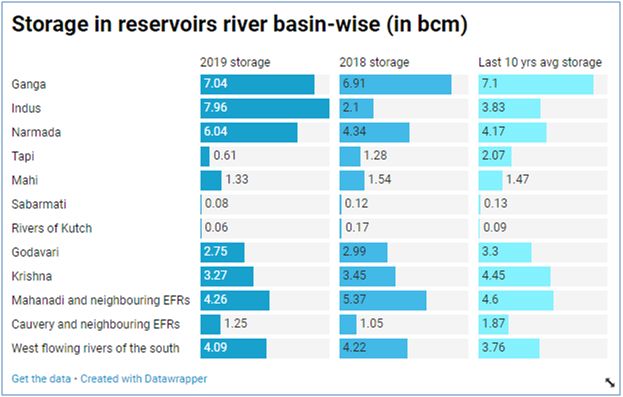
The recent data from the Central Water Commission (CWC), released on May 9, 2019 reveals a reassuring situation of water storage in the river basins of India. The overall water storage in the 91 reservoirs monitored is slightly more (105 percent) when compared to the average water storage over the last 10 years, the data shows. For the report, the CWC monitored 12 river basins for water storage; using the data on an average of the last 10 years, 2017-18 and 2018-19. Further, the live storage available in the reservoirs is 116 percent more than last year during the same period.
The 27 reservoirs under monitoring in the river basins in the western states of Gujarat and Maharashtra have a different story to tell. Their storage (15 percent) is way below the storage of last year (21 percent) and is also less than the average storage of the last 10 years (24 percent) during the corresponding period.

The river basin of Tapi is the worst affected indicating very deficient storage with shortfall of over 60 percent of normal storage. This is followed by Sabarmati, rivers of Kutch, Krishna, Cauvery and the neighbouring east flowing rivers which showed shortfall between 20-60 percent of normal storage. The water storage was seen to be improving at the river basins of the Indus, the Narmada and the west-flowing rivers of south. The river basins Ganga, Mahi, Godavari, Mahanadi and neighbouring east-flowing rivers reported close to normal reservoir storages.

The six reservoirs in the northern region in the states of Himachal Pradesh, Punjab and Rajasthan indicate storage of 49 percent of the total live storage. This is far above the 18 percent storage observed last year or even the 26 percent shown as the average of the last 10 years.
The 15 reservoirs in the eastern region states of Jharkhand, Odisha, West Bengal and Tripura indicate 31 percent of the total live storage capacity of these reservoirs. The storage was almost the same during the corresponding period in 2018 (33 percent) and the average storage of the last 10 years during the corresponding periods (28 percent).
The 12 reservoirs in the central region states of Uttar Pradesh, Uttarakhand, Madhya Pradesh and Chhattisgarh indicate 28 percent of the total live storage capacity of these reservoirs. This is slightly above the figure of 26 percent for last year and 25 percent for the last 10 years during the corresponding period.
For the southern region states of Andhra Pradesh, Telangana (AP & TG—combined projects in both states), Karnataka, Kerala and Tamil Nadu, the storage during the current year (14 percent) is better than the corresponding period of last year (13 percent) but it is less than the average storage of the last 10 years (16 percent) during the corresponding period.
The CWC data, based on monitoring live storage status of 91 reservoirs of the country, raises concern over water availability and questions our preparedness for dealing with shortages in western India and parts of southern India. It remains to be seen if the Tapi basin, which is the worst affected, has the potential to cope with extreme climatic uncertainties such as drought.
The data of CWC can be accessed here